The pandemic has created tectonic shifts in our lives and how we move around the city and it might be time to adjust our regional transportation policies to reflect these changes.
“Collectively, there’s a lot of little setbacks at a time when we thought our region was going to be making significant strides forward in providing more transportation options for people.”
— Eliot Rose, Metro
That’s just one of several important findings from a report by Metro to better understand the impact of recent shifts in regional mobility behaviors.
To prepare for the 2023 update of the Regional Transportation Plan (RTP), Metro hired a consultant to work with their transportation planners to better understand emerging trends.
The initial findings from the Emerging Transportation Trends Study were shared at the Joint Policy Advisory Committee on Transportation (JPACT) meeting last week.
Here’s a summary of the trends (emphases mine), taken from a February 17th memo (PDF) to JPACT members from Metro Senior Transportation Planner Eliot Rose and Fehr & Peers Senior Transportation Planner Briana Calhoun:
• Transit ridership will take several years longer than automobile traffic to return to pre- pandemic levels due to service cuts, changing travel patterns, and lingering health concerns.
• People of color will feel less safe traveling in public than before because of increased concerns about racist policing and pandemic-era anti-Asian racism.
• A significant share of workers will continue teleworking after the pandemic is over.
• Electric vehicles and e-bikes will be increasingly affordable, have longer ranges, and be easier to use.
• People will buy an increasing share of goods online.
• The boom in recreational bicycling during the pandemic could create an opportunity to further increase bicycle trips.
• Agencies will face the challenges of pandemic recovery (as well as other unanticipated changes) with limited resources and outdated processes.
• The increase in traffic deaths seen during the pandemic will continue into recovery.
And here are a few more slides from the meeting:
The report makes two broad observations that should be a red flag to policymakers and advocates: “Emerging trends stand to reverse progress toward on the region’s climate, equity and safety goals” and “Emerging trends are pushing our region toward a two-tiered transportation system.”
The report says even if the decline in transit ridership doesn’t show a significant impact on vehicle miles traveled (VMT) – if this trend continues, by 2025 it will have increased regional VMT by 0-2%. In order to meet the regional climate goals necessary for curbing the worst effects of climate change, people need to be riding transit far more than they did even before the pandemic, so this decline in ridership is a move in the wrong direction.
Another issue with public transit relates to what the report cites as “the increase in public incidents of racism, the dangers of walking to and waiting at a transit stop, reduced service, and increased public health concerns,” all of which have made it feel less safe and more inconvenient — especially to people who are Black or Asian or in other communities of color. “Transit cannot provide a truly equitable and sustainable alternative to driving until these issues are addressed,” reads the memo.
One of the bright spots was a boom in what the report calls “recreational cycling”. (Note: We put that in quotes because we don’t think it’s good practice to separate bicycle trip types. After all, planners and policymakers never do that for car and truck trips.)
Advertisement
As we reported in 2014, the Oregon Department of Transportation and Metro use datasets provided by Strava to analyze cycling trends. Briana Calhoun, the consultant with Fehr & Peers, said at JPACT last week that, “It’s not a perfect source of data, but it does provide us some information.” They found a strong uptick in bike trips logged via Strava from 2019 to 2020 for the entire metro region. “There may be multiple reasons why those long trips increased in 2020,” Calhoun said at the meeting. “But we do know that people were less comfortable using shared modes like transit and looked at other modes of travel to get around during that time.”
In response to these findings, Metro acknowledges a need to shift policies and practices. There are new categories of focus to pay attention to that were not so present before the pandemic. For instance, people work from home at far greater numbers now, and that may remain true in a post-pandemic future. Increased online shopping has also put a spotlight on the impact of delivery vehicles, which will be a new focus in the RTP update.
Metro Planner Eliot Rose told JPACT members on Thursday that a much broader shift in transportation planning might be necessary:
“We were really focused on commute trips, but people are taking a lot more other trips throughout the day now. We used to focus on how to get people to the store. And now we have an opportunity to focus on how goods from the store move to people. We thought about connecting people to jobs with transit passes and infrastructure and now maybe in this environment, having a computer and internet access as a more effective and advantageous way for people to be able to get ahead in our region’s economy… And lastly, understanding what’s going on with with peak travel which has been driving a lot of our transportation investment decisions… people are making fewer trips during the peak… The last data from ODOT for our region shows that highway trips are still down by three to 5% from pre-pandemic levels, there may be some opportunities in there to think about to think about our priorities for investment as we enter into the RTP.”
“None of these trends represent a major threat to our region’s goals in and of themselves,” Rose continued. “It’s more that collectively, there’s a lot of little setbacks at a time when we thought our region was going to be making significant strides forward in providing more transportation options for people. And that’s been a challenge.”
To help Metro better understand these trends, you can participate in the RTP update planning process by sharing your experiences in a survey which will be open for participation until April 3rd at 5:00 pm.

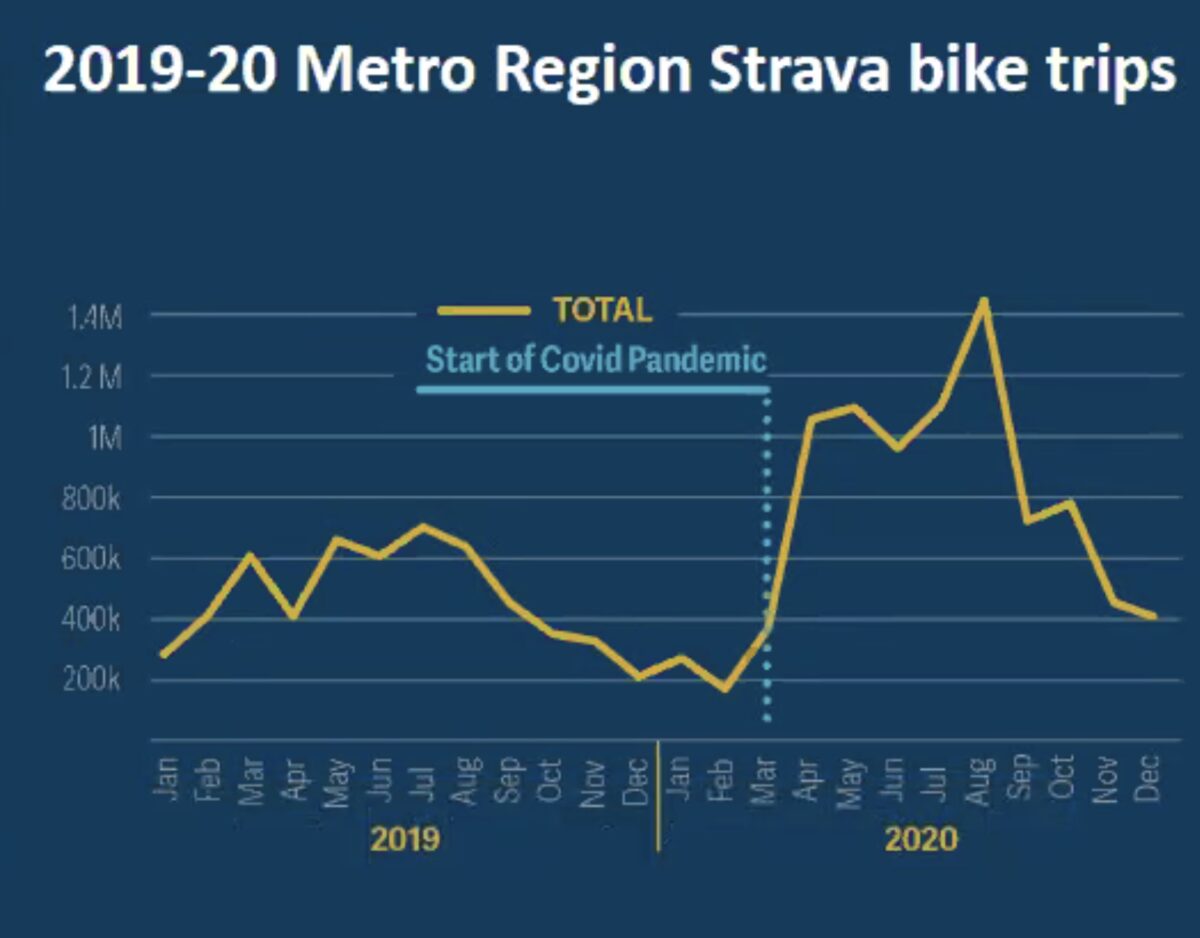


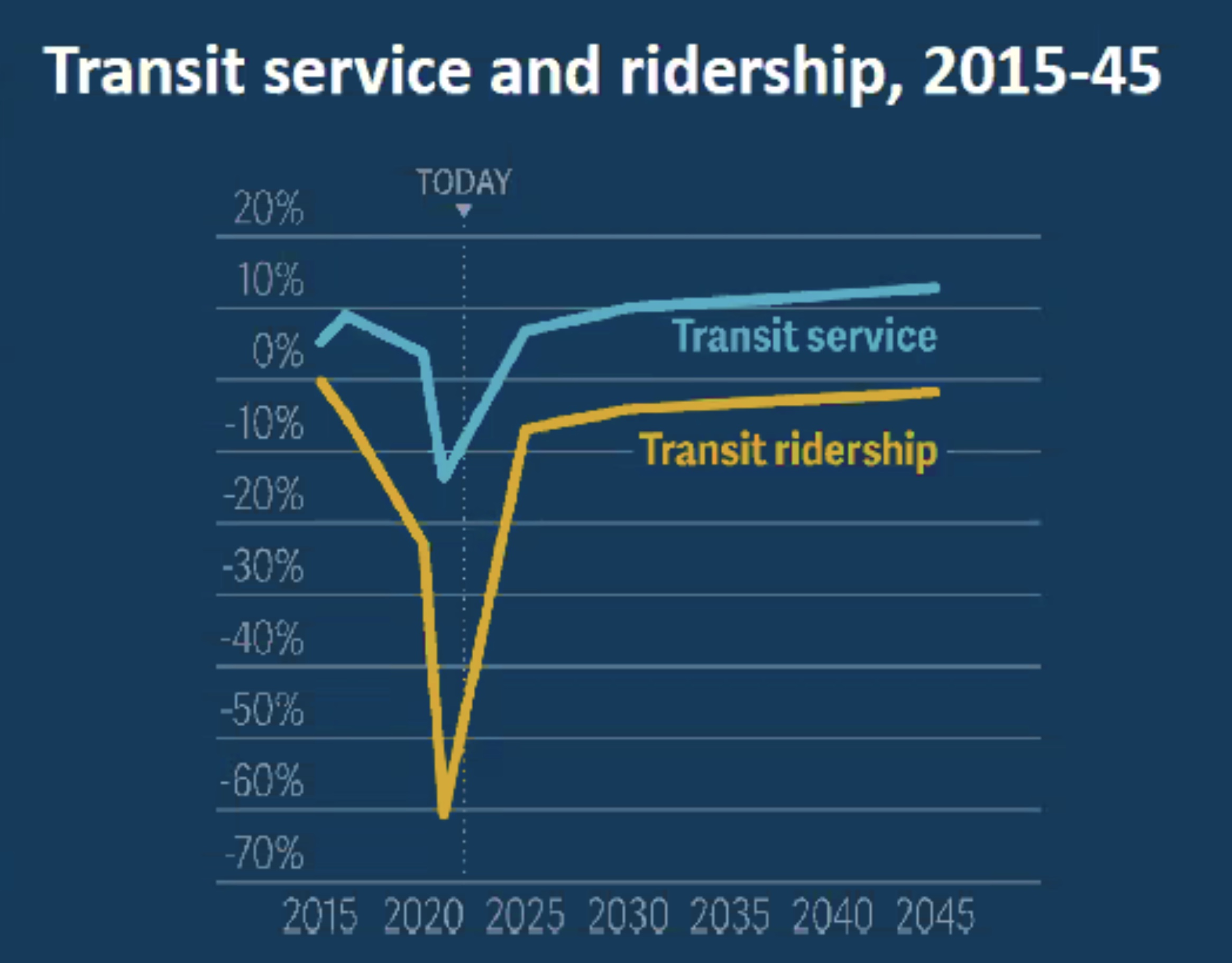


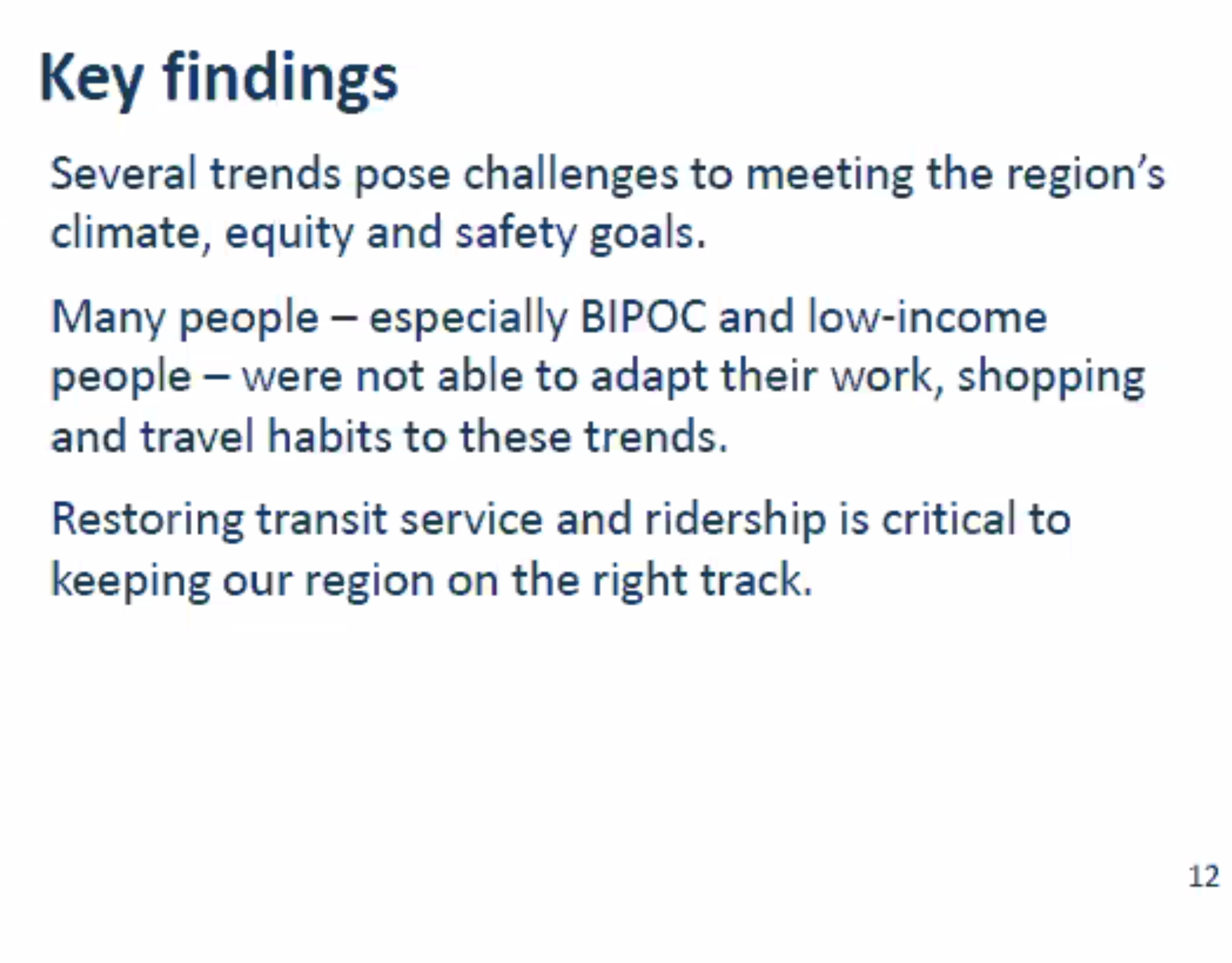
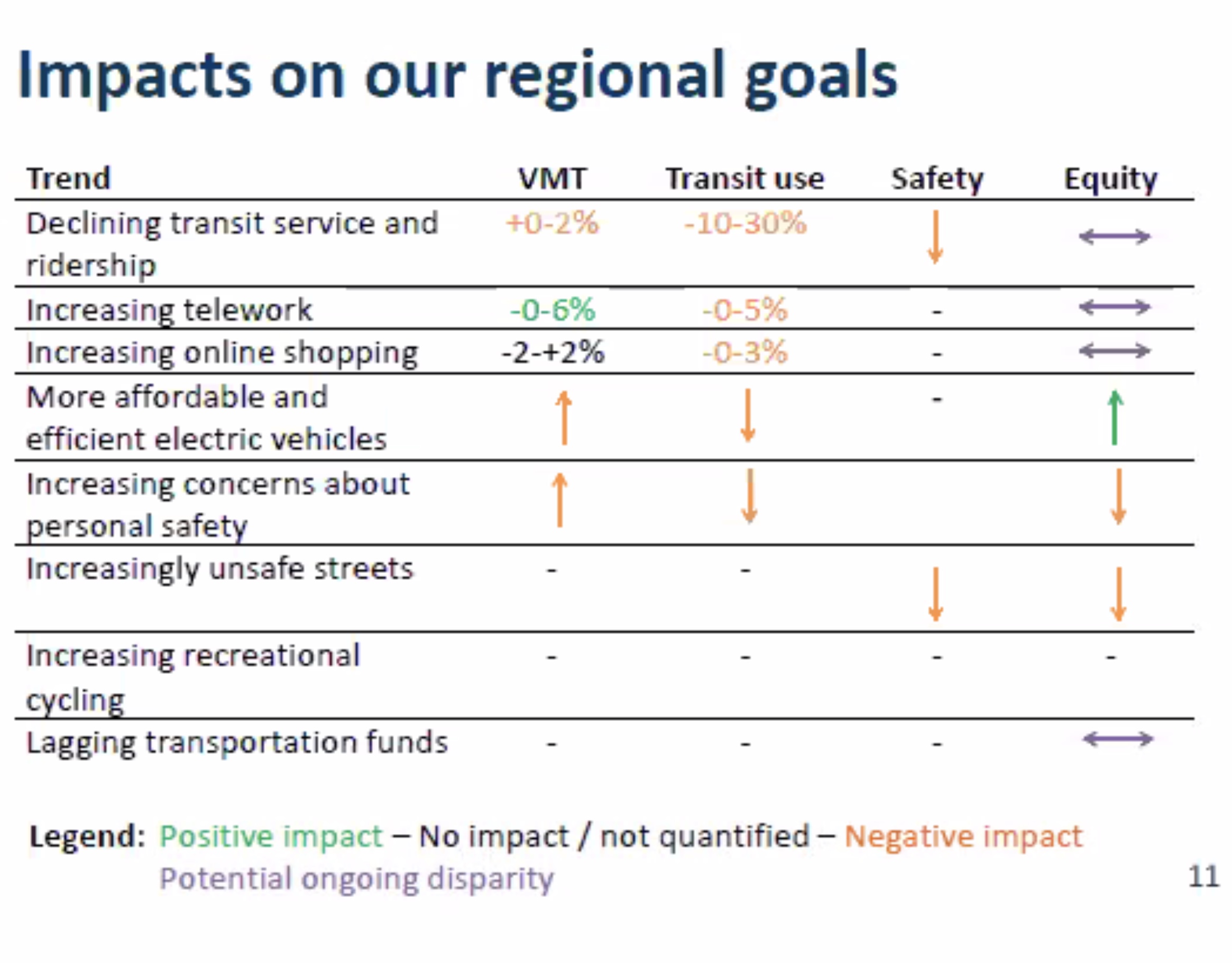

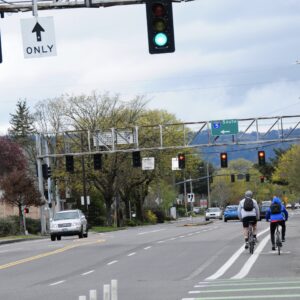

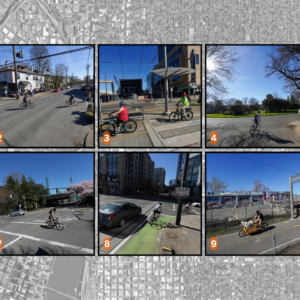
Thanks for reading.
BikePortland has served this community with independent community journalism since 2005. We rely on subscriptions from readers like you to survive. Your financial support is vital in keeping this valuable resource alive and well.
Please subscribe today to strengthen and expand our work.
Maybe they shouldn’t cut transit funding? It’s like they’ve never heard of the frequency-ridership spiral.
There’s also not been nearly enough physical reconstruction of the streets to reduce vehicle speeds and protect those traveling by foot or bicycle. I think, too, that as long as Portland a significant job center while the region as a whole remains behind the city in non-automobility, there’s going to be a fair amount of public pushback against shifting people out of cars. I live in Beaverton, and if I wasn’t commited to driving as little as possible, I’d find the overly-long traffic light cycles on 40-50mph arterials–where red light running is commonplace–on the way to the Beaverton Central MAX station–where twice in the last year, the train I needed to get to work was canceled without any warning, after I’d paid my fare–great excuses to drive the 3 miles to work.
I don’t think it can be denied, either, that there’s terrible TOD around MAX stations here. Strip malls, surface-level parking lots, multi-story parking garages, and empty plots of land? Around the stations of a system that cost billions of dollars to build? This is a problem.
TOD= terrible outcome developments
It just underscores that real climate plans include accessible, affordable (free) public transit AND resilient rolling and walking networks AND affordable housing. In some parts of Portland you can choose whether to bike it or bus it, but in large parts of the city and most of the suburbs it’s going to require a combination walk/ride + transit. And those locations are, not coincidentally, disproportionately places where it’s cheaper to live.
Transit needs to run more frequently — for too many it’s just not a practical option today compared to a vehicle — and should only tangentially relate to ridership, in the same way that we don’t decline to build fire stations in neighborhoods that haven’t had many fires. But transit also needs to be planned alongside and in conjunction with trails, greenways, MUPs, physically protected sidewalks and bike lanes, etc. and it needs to be reasonably close to where people can afford to live. The current trend of luxury “transit-oriented” development (whether that’s condos or upscale shops) is a marketing ploy for playground capitalism, not public policy.
TriMet needs to create a plan that encompasses frequent and free transit, safe walking and biking networks, and affordable housing — instead of the siloed approaches that result in housing with no transit, transit with no bike accommodations, greenways with no affordable housing, etc.
A comprehensive approach is (supposed to be) the whole reason we have entities like TriMet that encompass multiple municipalities, agencies and jurisdictions. Running some buses over here and opening some parks over there is really just not going to cut it anymore.
The point of the frequency-ridership spiral is that it can be negative–cut frequency, ridership drops–or positive–increase frequency, ridership rises.
Additionally, I’d be far more interested in having drivers actually pay for the services THEY use–roads everywhere, where they have priority 99.99% of the time–than in having transit riders ride for free. Proof-of-payment as it currently is is obviously not going to catch 100%, but it’s going to still encourage enough fare collection that it works to leave only those who’ll free-ride mostly because they have no choice. At least for rail service, the expensive part of providing it is in building the infrastructure; actually running the service is cheap, as rail vehicles and their associated infrastructure age very slowly, and a single driver can transport hundreds of passenger.
Providing free transit is only going to perpetuate the misguided image Americans have of transit as being for poor people, while not actually helping poor people very much, and would only further distract from the enormous subsidies that we already pay drivers through various means.
1. MAX is effectively free and its full of violent drug addicts who scare people on the regular–personally I’ve never experienced a public transport system in the world that is free or like MAX that way.
I’ve ridden frequently in London, Berlin, Paris, Rome, Milan, Madrid, New York, Chicago, Washington DC, San Francisco, Mumbai, Delhi, Osaka/Kobe, hmm did I leave any out…
none of them are free, all of them check fares, all of them have high transit ridership.
So I do not beleive free transit plays any role in any of the goals you mention. And as a car-less person in Portland and former daily rider of MAX I wholeheartedly disagree with you that it should be free.
2. You say we only build “luxury transit oriented development,” what is luxury to you–market rate? Market rate is not luxury. Its the market rate. Thats just the cost of living. In the cities I mention above, apartments cost what they cost. That’s life. And with the exception of India, those cities apartments, by their transit stations, all cost more than Portland apartments being built. And many of those cities have lower average incomes than Portland.
Lents town center, Hollywood, and Lloyd Center are the only stations that I know of (I don’t know the yellow line) that have been actually fulfilling the goal of having apartments built by the Max stops–and they aint luxury.
I feel as though your comment has a lot of good points but also is subject to alot of woke talking points.
….Let’s not bring the whole “woke” vs. “non-woke” thing into this. The point is that if your TOD being market-priced means that it’s not affordable, then you need to build more TOD. I know a lot of antigentrification people have fallen into the whole development=bad thing, and that criticism isn’t completely without merit, but the truth is that America simply does not build nearly enough housing to meet demand. Places with sharply rising housing costs simply need to build lots and lots of housing–high-rise and missing middle both. I see much less of either here than I’d expected after hearing about how “progressive” Portland and Oregon are on housing.
If riders really are avoiding TriMet because of both the presence of police (which is near zero at the moment) and the absence of security to prevent anti-Asian hate crime and provide physical security to BIPOC riders (not to mention everyone else), well, that’s going to be a tricky needle to thread.
But I am certain of one thing: if TriMet wants such steep growth in ridership rates, they’re going to need to get a handle on the perception of safety on transit vehicles.
Without that, the current system is toast.
My work is forcing us back to the office after the mask mandate is ended.
Myself, and quite a few co-workers, are dreading taking transit. Some have even come out to say that because of the continuing safety issues with Trimet they’ll refuse to use them to get to the office. They are looking to carpool or drive themselves.
I will take Trimet, not much choice for me unfortunately, but it will be very interesting how it goes since Trimet really doesn’t care about its paying passengers.
As a thought experiment, I wonder what would happen if buses arrived in pairs, one free, and one requiring fare accompanied by an officer enforcing them.
Which would folks choose to ride?
TriMet is more concerned with virtue signaling than actually delivering a good transit service. They sell the “idea” of transit to upper and middle income taxpayers who will never use it. A brilliant decoupling of perception and reality.
I honestly never see transit, here and nationally, recovering from the dip. Those who *can* will continue to avoid it and hasten it becoming exclusively the homeless/poor shuttle it already is. TriMet Management and board who have no experience with or personal stake in insuring transit works will continue to loudly advocate policies of free fare, lawlessness and general disorder because they want to feel warm and fuzzy.
Cleaning up our bike trials (MUP’s) and making them and public transit feel safe again would be a great way to shrink our carbon footprint and improve livability in Portland.
Back to the Strava Data: my eyes seem to be seeing that the COVID19 era was a ‘bubble of rides’ logged on Strava (the current level is at a similar point to the start of COVID)?! (This is similar to what I have seen in other areas per folks looking for other recreation options during early covid AND having more time to fill / flexibility etc.)
I will have to check out the METRO Report…as one financial area – pre COVID – that Transit has and will struggle with is how to fund the federal requirement for paratransit services? (It was not uncommon for many US systems to spend almost half of their operations budgets for this service type.)
The Metro graphs seem to me to be an exercise in cognitive dissonance and motivated thinking. Strava is mostly an indicator of MAPILs/MAFILs/MAMILs with the disposable income to purchase a narcissistic tracking app and has little correlation with actual transportation cycling — the type of cycling that actually replaces SUV/Truck trips. The EV graph intentionally obfuscates the pathetic failure of Oregon to meet its EV targets and it’s my guess that Oregon will continue to fail to electrify transportation in the next decade or so. (This has enormous implications for USAnian “green capitalist” competitiveness.) The transit graph is pure fantasy and a product of the authors’ denial of our Fordist capitalist system.
PS: It’s darkly comical that some of those who criticized the utility of census ACS data are perfectly fine with our plutocratic local government paying Strava for “data”. Is PDX going to hire Zillow to provide data for BDS next? FFS.
PPS: No amount of “carrot” will get “progressives” out of their SUVs in this increasingly unequal society. We need the stick, more carrot, and the redistribution that would pay for it all.
I really really like what E. Rose said about changing the trips we focus on: ie peak commuter trips instead all the other trips. This is an important shift in transport future projections thinking.
Refocusing leadership to consider the needs of all transport users and trips throughout the day. This by default is a more equitable method of ‘adjusting’ regional trips across the region and time of day trips.
The mere fact that highway trips are reducing is evidence of everybody rerouting their trips to avoid congestions during peak times. This is resilience. This should be encouraged.
As per safety on transit; we took kids on school trips on TriMet. Everybody behaves better when children are around. Somehow start with the kids returning to school on shared public transit.
We should also consider ‘breaking up’. Portland Public School district. Too big to fail? Or too big to actually deliver? Why in gods name would they suggest moving Harriet Tubman to displace another historically disadvantaged school?
IDK but all these ‘building bonds’ new facilities don’t deliver educational results that putting that same money towards operations and maintenance, teachers and aid staff does more to improve learning then fancy new buildings. Anyhoo I digress, but most kids 12 and above should be able to safely ride the public bus a short distance to school.
While PPS can be criticized for going a bit over the top with certain features, the main function of these “fancy new buildings” is to not crush our children to death during a Cascadia subduction earthquake. They also are significantly more energy efficient, saving the district in operating costs.
Does anyone see a few problems with using STRAVA as a metric for all bike trips?

https://www.strava.com/heatmap#13.00/-122.67144/45.56776/bluered/ride